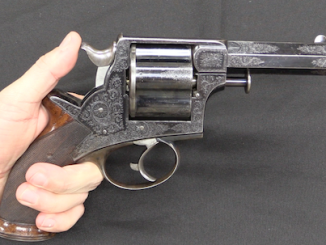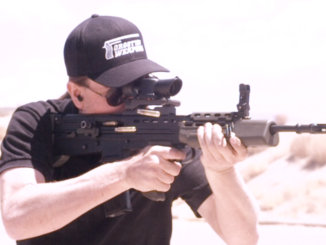Designed in an effort to compete with the then-new Colt/Browning air cooled 1895 machine gun, the Extra-Light Maxim weighted in at just 27 (maybe 28) pounds for the gun, and 44 pounds with tripod. This may sound heavy, but it was a remarkable improvement over the 100+ pounds of most models of Maxim with mount. The water jacket was replaced with an air jacket (necessary to support the muzzle), and the whole gun was narrowed. The mainspring was moved to the inside of the receiver, allowing lighter construction but complicating disassembly and removing the ability to tune the mainspring tension to fit a particular batch of ammunition.
The concept proved to be a commercial failure, as the air cooling lacked the sustained fire capability that militaries were looking for. A total of 135 examples were made, but most were sold in small orders for testing, with no major contracts forthcoming.
Many thanks to the Royal Armouries for allowing me to film this tremendously rare artifact! The NFC collection there – perhaps the best military small arms collection in Western Europe – is available by appointment to researchers, but you can browse the various Armouries collections online.




I suspect cooling fins would make the barrel jacket less likely to burn out, but that would add more weight. As for machine gun doctrine, a lightweight belt-fed gun shouldn’t be asked for a 50-round spray in the first place! Then again, most people expected all machine guns (regardless of weight class) to spray like crazy anyway! I probably messed up, but who knows?
“suspect cooling fins would make the barrel jacket less likely to burn out, but that would add more weight”
Well, problem of turning Maxim design into air-cooled would return during Great War. These circumstances prompted development of full redesigned jacket:
https://vickersmg.blog/the-guns/
Most Maxim guns with mounts were in the 150 pound class. The Colt 1895 was about 100 pounds with gun, tripod, and mount, making the Colt pretty easy to carry in three quick detachable pieces. Heavy mounts contributed to firing stability and overall ruggedness.
“(…)pound(…)”
According to: http://www.gutenberg.org/ebooks/41160
Colt automatic gun[that is machine gun in modern parlance]is an American invention whose automatic action is due to explosion of the charge, not to recoil[as opposed to Maxim]. The force by which the motions of firing, extracting, and loading are performed is derived from the powder-gases, a portion of which—passing through a small vent[that is gas port in modern parlance]in the muzzle—acts by means of a lever on the mechanism of the gun.
(…)
The machine weighs 40 lbs., and for use by cavalry or infantry can be mounted on the Dundonald Galloping Carriage. The ammunition-box, containing 2000 rounds ready for use, carries the gun on its upper side, and is mounted on a strong steel axle. A pole with a slotted end is inserted into a revolving funnel on the bend of the shaft, the limbering-up being completed by an automatic bolt and plug.
The gun-carriage itself is of steel, with hickory wheels and hickory and steel shafts, detachable at will. The simple harness suits any saddled cavalry horse, and the shafts work in sockets behind the rider’s legs. Its whole weight with full load of ammunition is under four hundredweight[around 203 kg using modern measurement system]/
DISCLAIMER: This source represent state of knowledge as of 1907.
The ornate grip, opulent finishes… I can see where that pathos of war is coming from. Meticulous and primitive at the same time.
I wonder if this exact Maxim Gun from the video is one of the two from the tricycle?
In several ways, this was a forerunner of the M1919 Browning air-cooled .30 tripod mounted medium machine gun, developed from the M1917 water-cooled browning .30 heavy MG.
In each case, the designer created a lightened, air-cooled version of an existing water-cooled heavy machine gun, with less sustained-fire capability but with greater mobility to somewhat make up for it.
Later of course both the Germans (with the experimental MG 08/18) and the Americans (with the WW2-issue Browning M1919A6) carried things a bit too far, in the process learning that there is a fundamental difference between a properly-designed, tripod-mounted, air-cooled medium MG and a properly-designed, bipod-mounted, air-cooled light MG. “And never the twain shall meet”.
Sort of like trying to turn a 5.56mm SAW into a GPMG, today. Sort of the same error made in the opposite direction, as it were.
cheers
eon
“(…)both the Germans (with the experimental MG 08/18) and the Americans (with the WW2-issue Browning M1919A6) carried things a bit too far, in the process learning that there is a fundamental difference between a properly-designed, tripod-mounted, air-cooled medium MG and a properly-designed, bipod-mounted, air-cooled light MG(…)”
As did Soviets with Maxim-Tokarev (see 5th image from top):
https://modernfirearms.net/en/machineguns/russia-machineguns/maksim-m191030-eng/
it was produced only for 2 years and dropped from production as DP became available.
“Americans(…)bit too far(…)fundamental difference between a properly-designed, tripod-mounted, air-cooled medium MG and a properly-designed, bipod-mounted, air-cooled light MG.”
Amateurs! During Great War Austria-Hungary issued light (or rather lightened) machine gun variation of Schwarzlose, complete with water-cooling system, see first image from top: http://ww1.milua.org/shvarzloze07-ruch.htm
its empty mass was 20,4 kg and was issued with belt-100 rather than default, but it accepted also later.
There is a tidy, tripod-mounted example of an Extra-Light Maxim (sn 5431) at the QE2 Army Museum in Waiouru, New Zealand. It is a trophy from the Boer War.